Tesla Stakeholder Analysis and Strategy Development Report
VerifiedAdded on 2023/01/18
|15
|3284
|64
Report
AI Summary
This report provides a detailed stakeholder analysis of Tesla Motors, examining the company's relationships with various stakeholder groups. It begins with an overview of the stakeholder theory and its relevance to Tesla, followed by an in-depth analysis of four key stakeholder groups: government, competitors, suppliers, and customers. For each group, the report assesses their influence, interests, and potential impact on Tesla's business. The analysis includes an identification of stakeholder categories and the application of generic strategic programs such as 'involve', 'monitor', 'collaborate', and 'defend' strategies. The report then recommends specific strategic programs tailored to each stakeholder group, providing justifications for these recommendations based on the analysis. The recommendations aim to help Tesla effectively manage its relationships with each stakeholder group to enhance its business performance and achieve its strategic goals in the dynamic electric vehicle market.
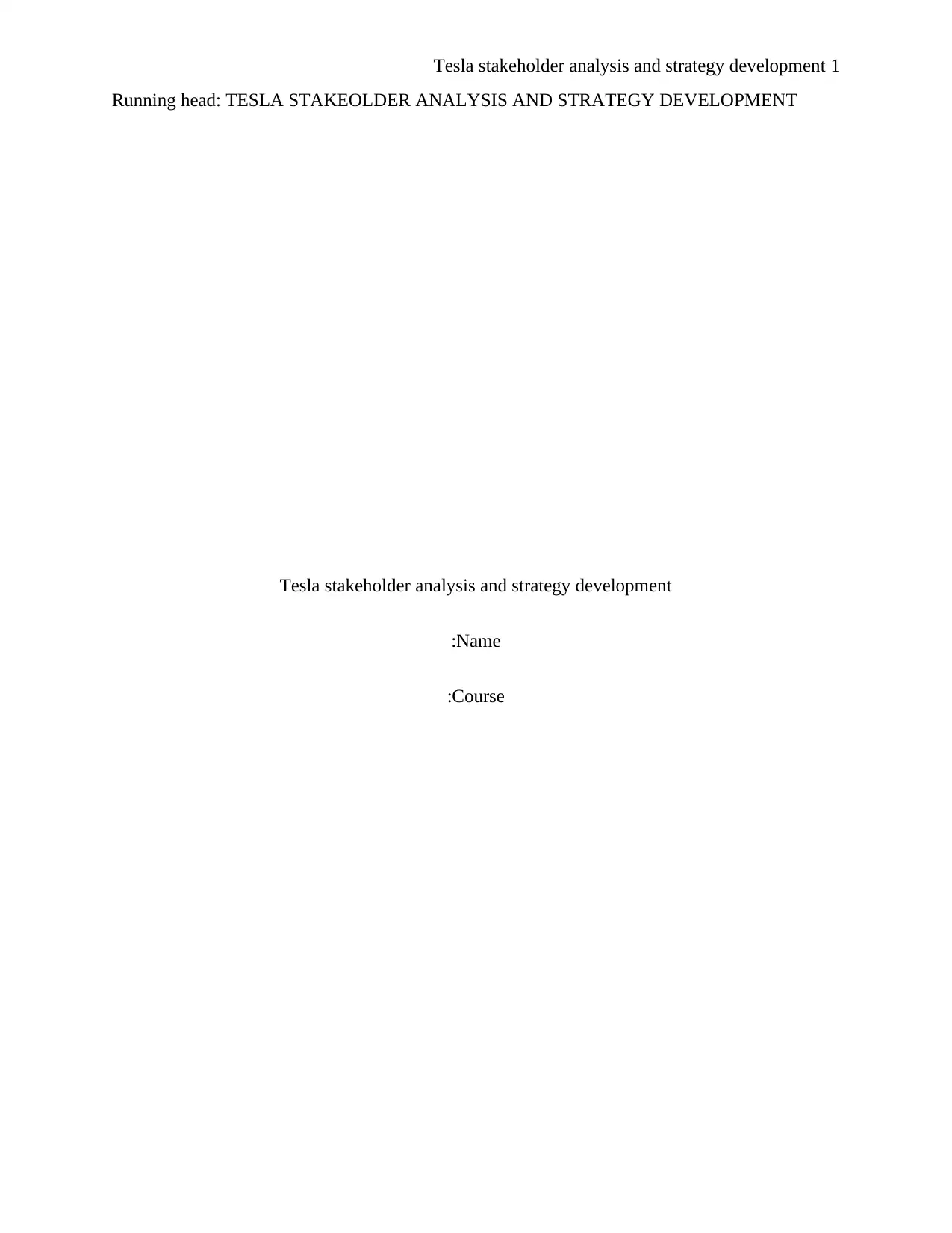
1Tesla stakeholder analysis and strategy development
Running head: TESLA STAKEOLDER ANALYSIS AND STRATEGY DEVELOPMENT
Tesla stakeholder analysis and strategy development
Name:
Course:
Running head: TESLA STAKEOLDER ANALYSIS AND STRATEGY DEVELOPMENT
Tesla stakeholder analysis and strategy development
Name:
Course:
Paraphrase This Document
Need a fresh take? Get an instant paraphrase of this document with our AI Paraphraser
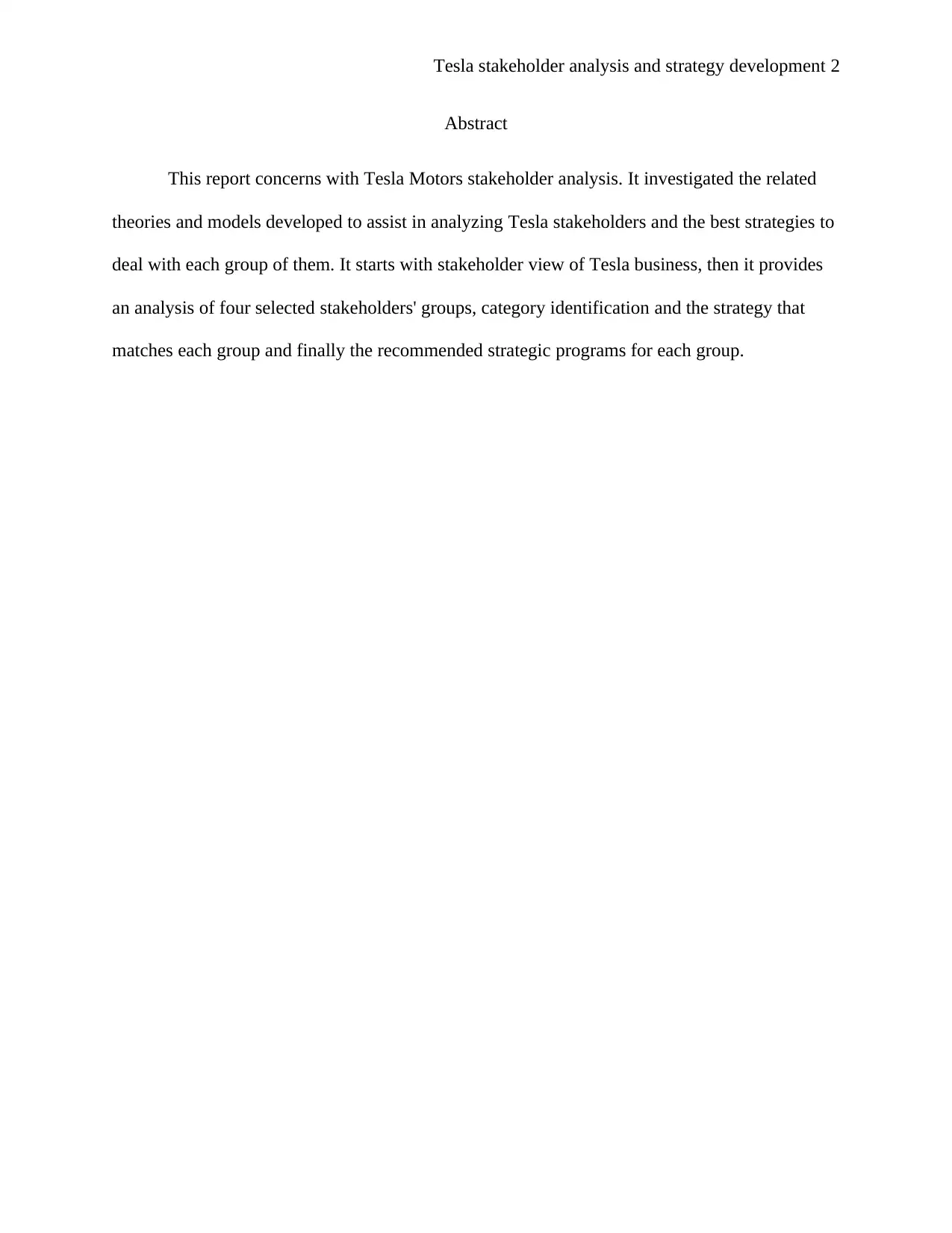
2Tesla stakeholder analysis and strategy development
Abstract
This report concerns with Tesla Motors stakeholder analysis. It investigated the related
theories and models developed to assist in analyzing Tesla stakeholders and the best strategies to
deal with each group of them. It starts with stakeholder view of Tesla business, then it provides
an analysis of four selected stakeholders' groups, category identification and the strategy that
matches each group and finally the recommended strategic programs for each group.
Abstract
This report concerns with Tesla Motors stakeholder analysis. It investigated the related
theories and models developed to assist in analyzing Tesla stakeholders and the best strategies to
deal with each group of them. It starts with stakeholder view of Tesla business, then it provides
an analysis of four selected stakeholders' groups, category identification and the strategy that
matches each group and finally the recommended strategic programs for each group.
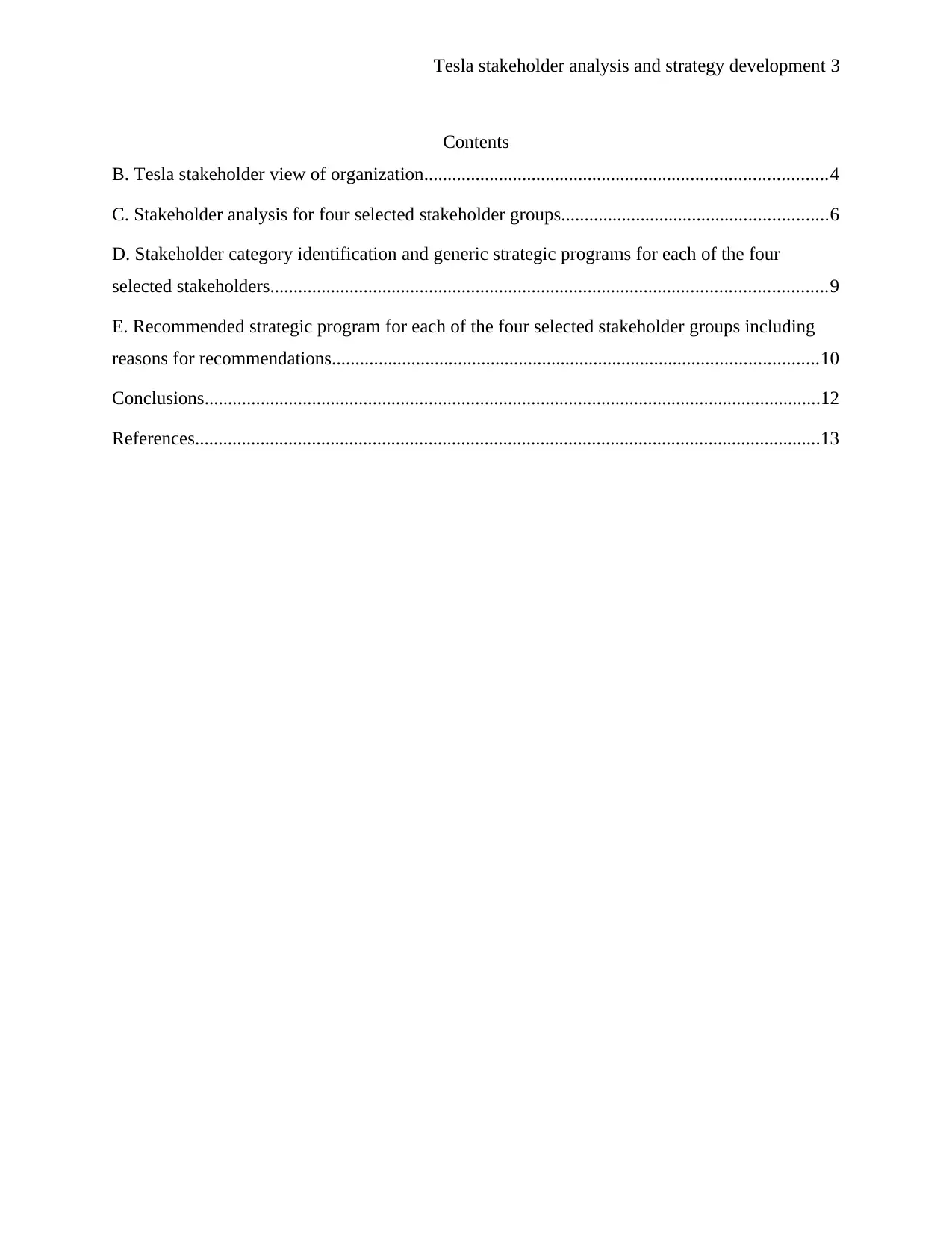
3Tesla stakeholder analysis and strategy development
Contents
B. Tesla stakeholder view of organization......................................................................................4
C. Stakeholder analysis for four selected stakeholder groups.........................................................6
D. Stakeholder category identification and generic strategic programs for each of the four
selected stakeholders.......................................................................................................................9
E. Recommended strategic program for each of the four selected stakeholder groups including
reasons for recommendations........................................................................................................10
Conclusions....................................................................................................................................12
References......................................................................................................................................13
Contents
B. Tesla stakeholder view of organization......................................................................................4
C. Stakeholder analysis for four selected stakeholder groups.........................................................6
D. Stakeholder category identification and generic strategic programs for each of the four
selected stakeholders.......................................................................................................................9
E. Recommended strategic program for each of the four selected stakeholder groups including
reasons for recommendations........................................................................................................10
Conclusions....................................................................................................................................12
References......................................................................................................................................13
⊘ This is a preview!⊘
Do you want full access?
Subscribe today to unlock all pages.

Trusted by 1+ million students worldwide
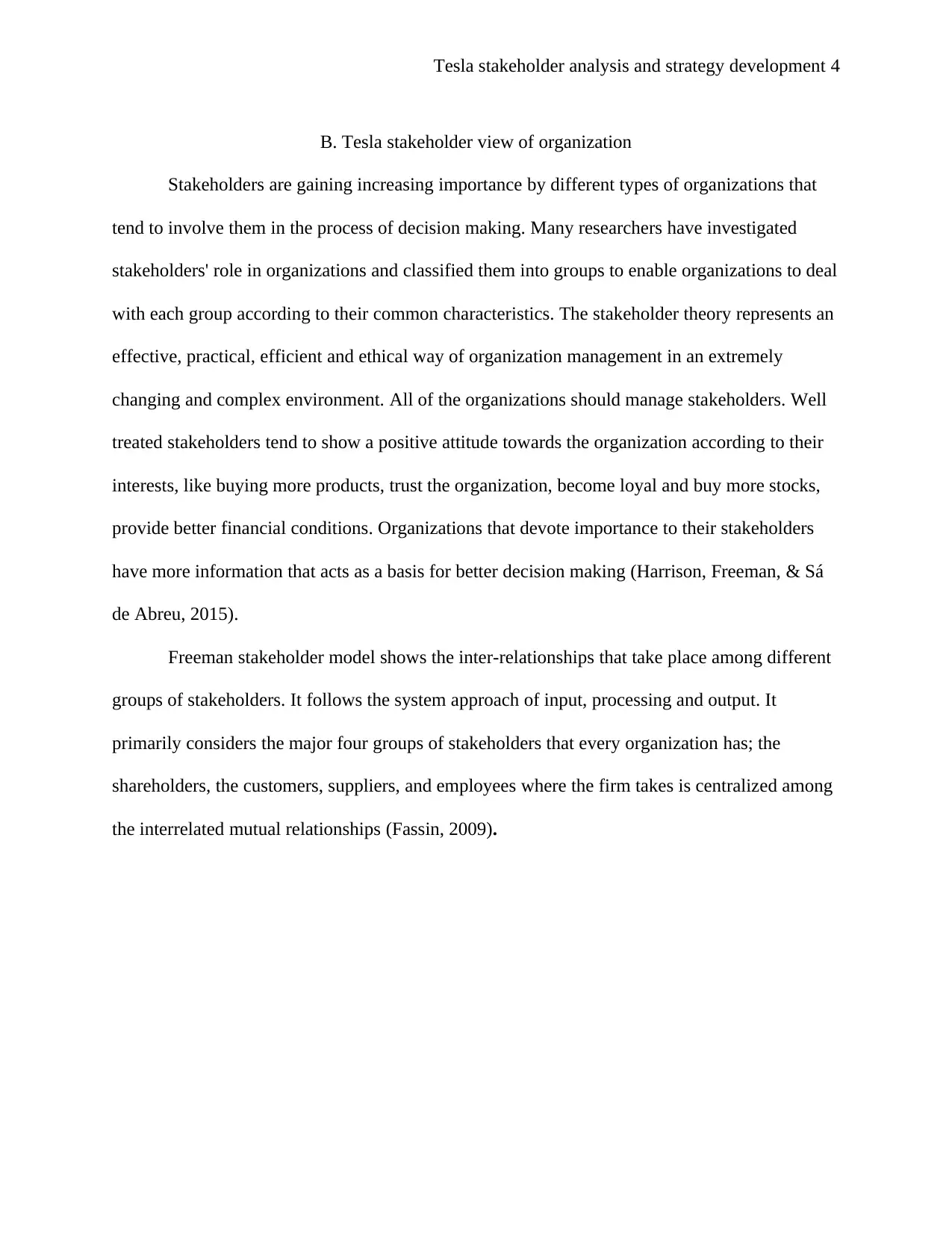
4Tesla stakeholder analysis and strategy development
B. Tesla stakeholder view of organization
Stakeholders are gaining increasing importance by different types of organizations that
tend to involve them in the process of decision making. Many researchers have investigated
stakeholders' role in organizations and classified them into groups to enable organizations to deal
with each group according to their common characteristics. The stakeholder theory represents an
effective, practical, efficient and ethical way of organization management in an extremely
changing and complex environment. All of the organizations should manage stakeholders. Well
treated stakeholders tend to show a positive attitude towards the organization according to their
interests, like buying more products, trust the organization, become loyal and buy more stocks,
provide better financial conditions. Organizations that devote importance to their stakeholders
have more information that acts as a basis for better decision making (Harrison, Freeman, & Sá
de Abreu, 2015).
Freeman stakeholder model shows the inter-relationships that take place among different
groups of stakeholders. It follows the system approach of input, processing and output. It
primarily considers the major four groups of stakeholders that every organization has; the
shareholders, the customers, suppliers, and employees where the firm takes is centralized among
the interrelated mutual relationships (Fassin, 2009).
B. Tesla stakeholder view of organization
Stakeholders are gaining increasing importance by different types of organizations that
tend to involve them in the process of decision making. Many researchers have investigated
stakeholders' role in organizations and classified them into groups to enable organizations to deal
with each group according to their common characteristics. The stakeholder theory represents an
effective, practical, efficient and ethical way of organization management in an extremely
changing and complex environment. All of the organizations should manage stakeholders. Well
treated stakeholders tend to show a positive attitude towards the organization according to their
interests, like buying more products, trust the organization, become loyal and buy more stocks,
provide better financial conditions. Organizations that devote importance to their stakeholders
have more information that acts as a basis for better decision making (Harrison, Freeman, & Sá
de Abreu, 2015).
Freeman stakeholder model shows the inter-relationships that take place among different
groups of stakeholders. It follows the system approach of input, processing and output. It
primarily considers the major four groups of stakeholders that every organization has; the
shareholders, the customers, suppliers, and employees where the firm takes is centralized among
the interrelated mutual relationships (Fassin, 2009).
Paraphrase This Document
Need a fresh take? Get an instant paraphrase of this document with our AI Paraphraser
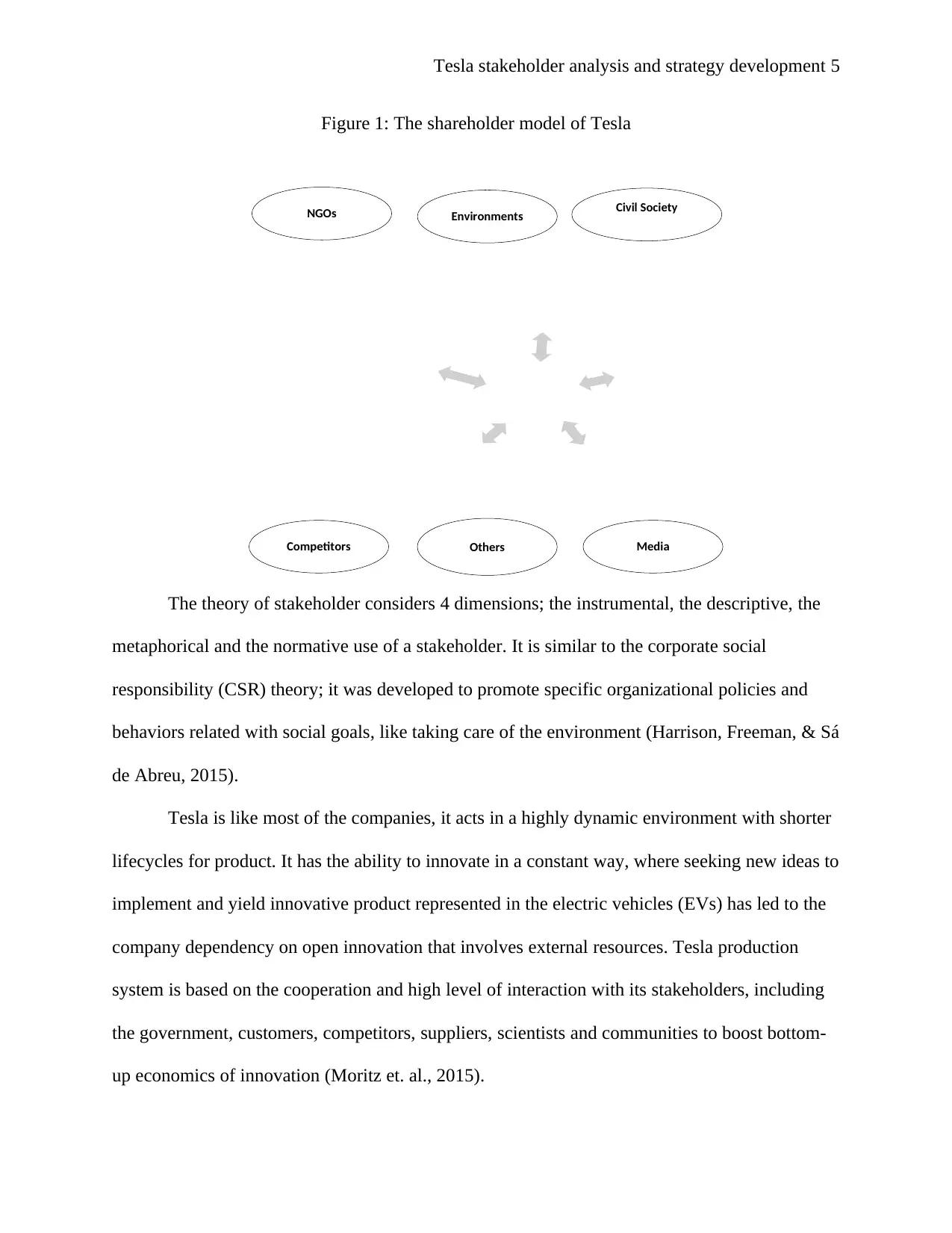
5Tesla stakeholder analysis and strategy development
Figure 1: The shareholder model of Tesla
The theory of stakeholder considers 4 dimensions; the instrumental, the descriptive, the
metaphorical and the normative use of a stakeholder. It is similar to the corporate social
responsibility (CSR) theory; it was developed to promote specific organizational policies and
behaviors related with social goals, like taking care of the environment (Harrison, Freeman, & Sá
de Abreu, 2015).
Tesla is like most of the companies, it acts in a highly dynamic environment with shorter
lifecycles for product. It has the ability to innovate in a constant way, where seeking new ideas to
implement and yield innovative product represented in the electric vehicles (EVs) has led to the
company dependency on open innovation that involves external resources. Tesla production
system is based on the cooperation and high level of interaction with its stakeholders, including
the government, customers, competitors, suppliers, scientists and communities to boost bottom-
up economics of innovation (Moritz et. al., 2015).
Tesla
Customers
Employees
GovernmentSuppliers
Shareholders
Environments Civil Society
NGOs
Others MediaCompetitors
Figure 1: The shareholder model of Tesla
The theory of stakeholder considers 4 dimensions; the instrumental, the descriptive, the
metaphorical and the normative use of a stakeholder. It is similar to the corporate social
responsibility (CSR) theory; it was developed to promote specific organizational policies and
behaviors related with social goals, like taking care of the environment (Harrison, Freeman, & Sá
de Abreu, 2015).
Tesla is like most of the companies, it acts in a highly dynamic environment with shorter
lifecycles for product. It has the ability to innovate in a constant way, where seeking new ideas to
implement and yield innovative product represented in the electric vehicles (EVs) has led to the
company dependency on open innovation that involves external resources. Tesla production
system is based on the cooperation and high level of interaction with its stakeholders, including
the government, customers, competitors, suppliers, scientists and communities to boost bottom-
up economics of innovation (Moritz et. al., 2015).
Tesla
Customers
Employees
GovernmentSuppliers
Shareholders
Environments Civil Society
NGOs
Others MediaCompetitors
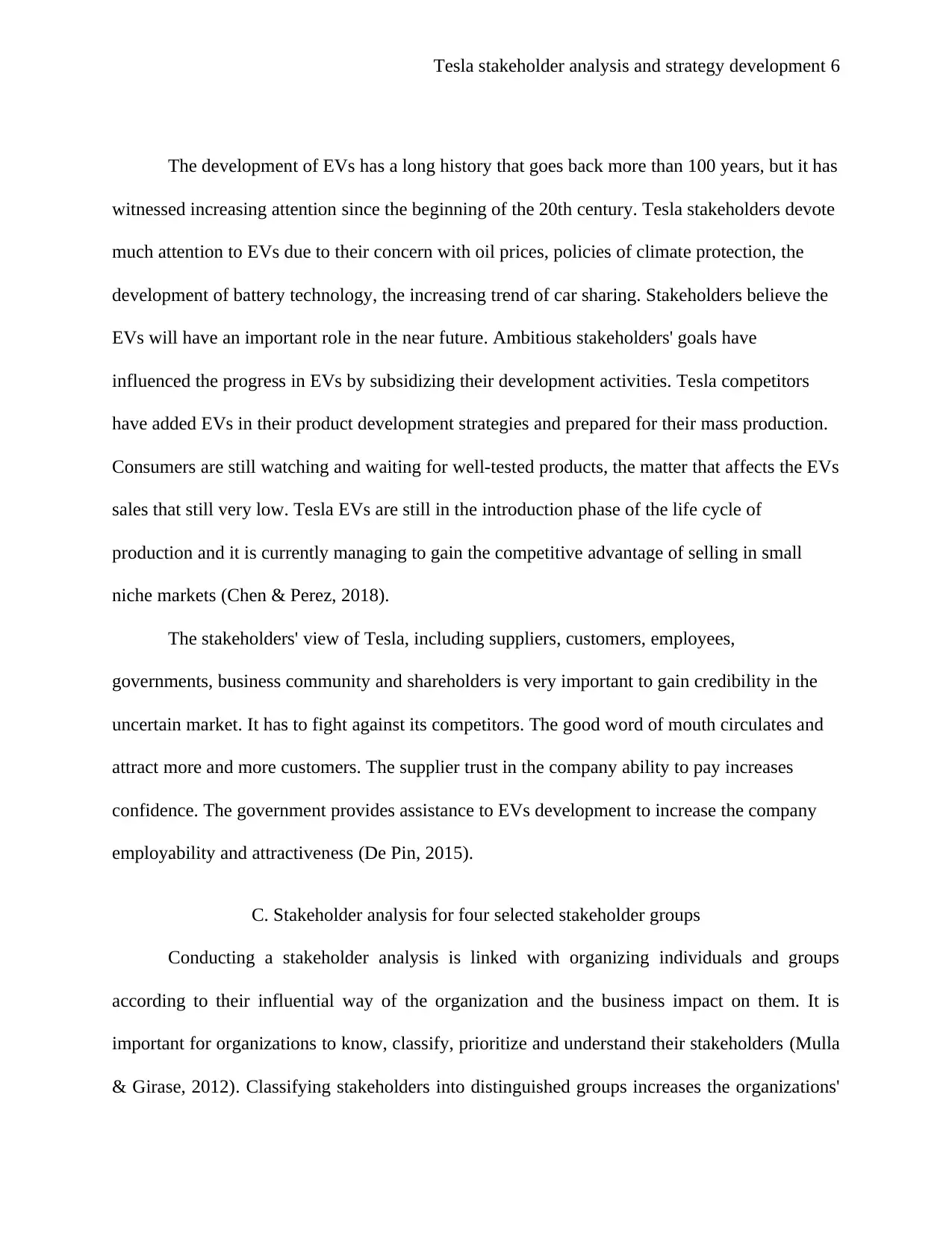
6Tesla stakeholder analysis and strategy development
The development of EVs has a long history that goes back more than 100 years, but it has
witnessed increasing attention since the beginning of the 20th century. Tesla stakeholders devote
much attention to EVs due to their concern with oil prices, policies of climate protection, the
development of battery technology, the increasing trend of car sharing. Stakeholders believe the
EVs will have an important role in the near future. Ambitious stakeholders' goals have
influenced the progress in EVs by subsidizing their development activities. Tesla competitors
have added EVs in their product development strategies and prepared for their mass production.
Consumers are still watching and waiting for well-tested products, the matter that affects the EVs
sales that still very low. Tesla EVs are still in the introduction phase of the life cycle of
production and it is currently managing to gain the competitive advantage of selling in small
niche markets (Chen & Perez, 2018).
The stakeholders' view of Tesla, including suppliers, customers, employees,
governments, business community and shareholders is very important to gain credibility in the
uncertain market. It has to fight against its competitors. The good word of mouth circulates and
attract more and more customers. The supplier trust in the company ability to pay increases
confidence. The government provides assistance to EVs development to increase the company
employability and attractiveness (De Pin, 2015).
C. Stakeholder analysis for four selected stakeholder groups
Conducting a stakeholder analysis is linked with organizing individuals and groups
according to their influential way of the organization and the business impact on them. It is
important for organizations to know, classify, prioritize and understand their stakeholders (Mulla
& Girase, 2012). Classifying stakeholders into distinguished groups increases the organizations'
The development of EVs has a long history that goes back more than 100 years, but it has
witnessed increasing attention since the beginning of the 20th century. Tesla stakeholders devote
much attention to EVs due to their concern with oil prices, policies of climate protection, the
development of battery technology, the increasing trend of car sharing. Stakeholders believe the
EVs will have an important role in the near future. Ambitious stakeholders' goals have
influenced the progress in EVs by subsidizing their development activities. Tesla competitors
have added EVs in their product development strategies and prepared for their mass production.
Consumers are still watching and waiting for well-tested products, the matter that affects the EVs
sales that still very low. Tesla EVs are still in the introduction phase of the life cycle of
production and it is currently managing to gain the competitive advantage of selling in small
niche markets (Chen & Perez, 2018).
The stakeholders' view of Tesla, including suppliers, customers, employees,
governments, business community and shareholders is very important to gain credibility in the
uncertain market. It has to fight against its competitors. The good word of mouth circulates and
attract more and more customers. The supplier trust in the company ability to pay increases
confidence. The government provides assistance to EVs development to increase the company
employability and attractiveness (De Pin, 2015).
C. Stakeholder analysis for four selected stakeholder groups
Conducting a stakeholder analysis is linked with organizing individuals and groups
according to their influential way of the organization and the business impact on them. It is
important for organizations to know, classify, prioritize and understand their stakeholders (Mulla
& Girase, 2012). Classifying stakeholders into distinguished groups increases the organizations'
⊘ This is a preview!⊘
Do you want full access?
Subscribe today to unlock all pages.

Trusted by 1+ million students worldwide
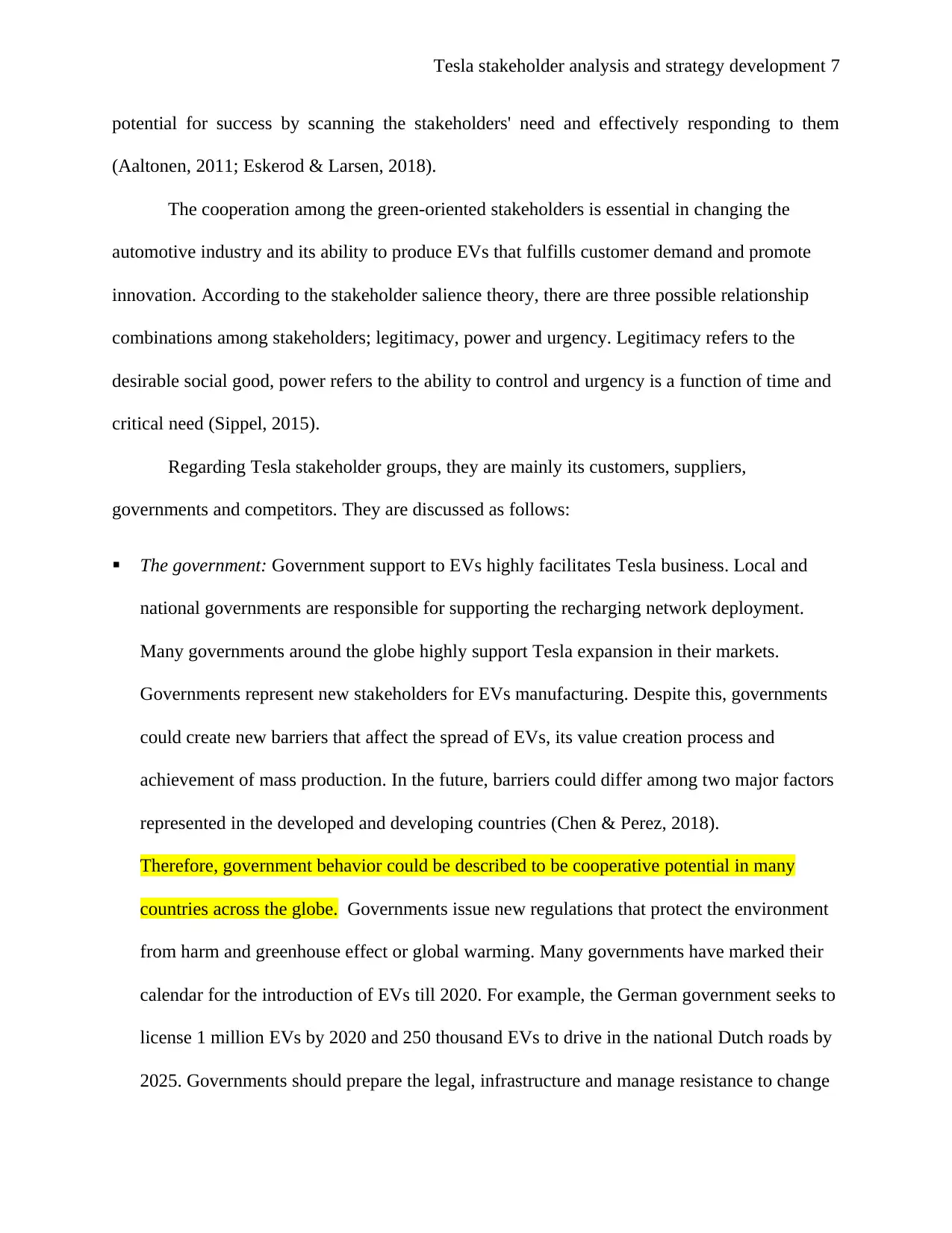
7Tesla stakeholder analysis and strategy development
potential for success by scanning the stakeholders' need and effectively responding to them
(Aaltonen, 2011; Eskerod & Larsen, 2018).
The cooperation among the green-oriented stakeholders is essential in changing the
automotive industry and its ability to produce EVs that fulfills customer demand and promote
innovation. According to the stakeholder salience theory, there are three possible relationship
combinations among stakeholders; legitimacy, power and urgency. Legitimacy refers to the
desirable social good, power refers to the ability to control and urgency is a function of time and
critical need (Sippel, 2015).
Regarding Tesla stakeholder groups, they are mainly its customers, suppliers,
governments and competitors. They are discussed as follows:
The government: Government support to EVs highly facilitates Tesla business. Local and
national governments are responsible for supporting the recharging network deployment.
Many governments around the globe highly support Tesla expansion in their markets.
Governments represent new stakeholders for EVs manufacturing. Despite this, governments
could create new barriers that affect the spread of EVs, its value creation process and
achievement of mass production. In the future, barriers could differ among two major factors
represented in the developed and developing countries (Chen & Perez, 2018).
Therefore, government behavior could be described to be cooperative potential in many
countries across the globe. Governments issue new regulations that protect the environment
from harm and greenhouse effect or global warming. Many governments have marked their
calendar for the introduction of EVs till 2020. For example, the German government seeks to
license 1 million EVs by 2020 and 250 thousand EVs to drive in the national Dutch roads by
2025. Governments should prepare the legal, infrastructure and manage resistance to change
potential for success by scanning the stakeholders' need and effectively responding to them
(Aaltonen, 2011; Eskerod & Larsen, 2018).
The cooperation among the green-oriented stakeholders is essential in changing the
automotive industry and its ability to produce EVs that fulfills customer demand and promote
innovation. According to the stakeholder salience theory, there are three possible relationship
combinations among stakeholders; legitimacy, power and urgency. Legitimacy refers to the
desirable social good, power refers to the ability to control and urgency is a function of time and
critical need (Sippel, 2015).
Regarding Tesla stakeholder groups, they are mainly its customers, suppliers,
governments and competitors. They are discussed as follows:
The government: Government support to EVs highly facilitates Tesla business. Local and
national governments are responsible for supporting the recharging network deployment.
Many governments around the globe highly support Tesla expansion in their markets.
Governments represent new stakeholders for EVs manufacturing. Despite this, governments
could create new barriers that affect the spread of EVs, its value creation process and
achievement of mass production. In the future, barriers could differ among two major factors
represented in the developed and developing countries (Chen & Perez, 2018).
Therefore, government behavior could be described to be cooperative potential in many
countries across the globe. Governments issue new regulations that protect the environment
from harm and greenhouse effect or global warming. Many governments have marked their
calendar for the introduction of EVs till 2020. For example, the German government seeks to
license 1 million EVs by 2020 and 250 thousand EVs to drive in the national Dutch roads by
2025. Governments should prepare the legal, infrastructure and manage resistance to change
Paraphrase This Document
Need a fresh take? Get an instant paraphrase of this document with our AI Paraphraser
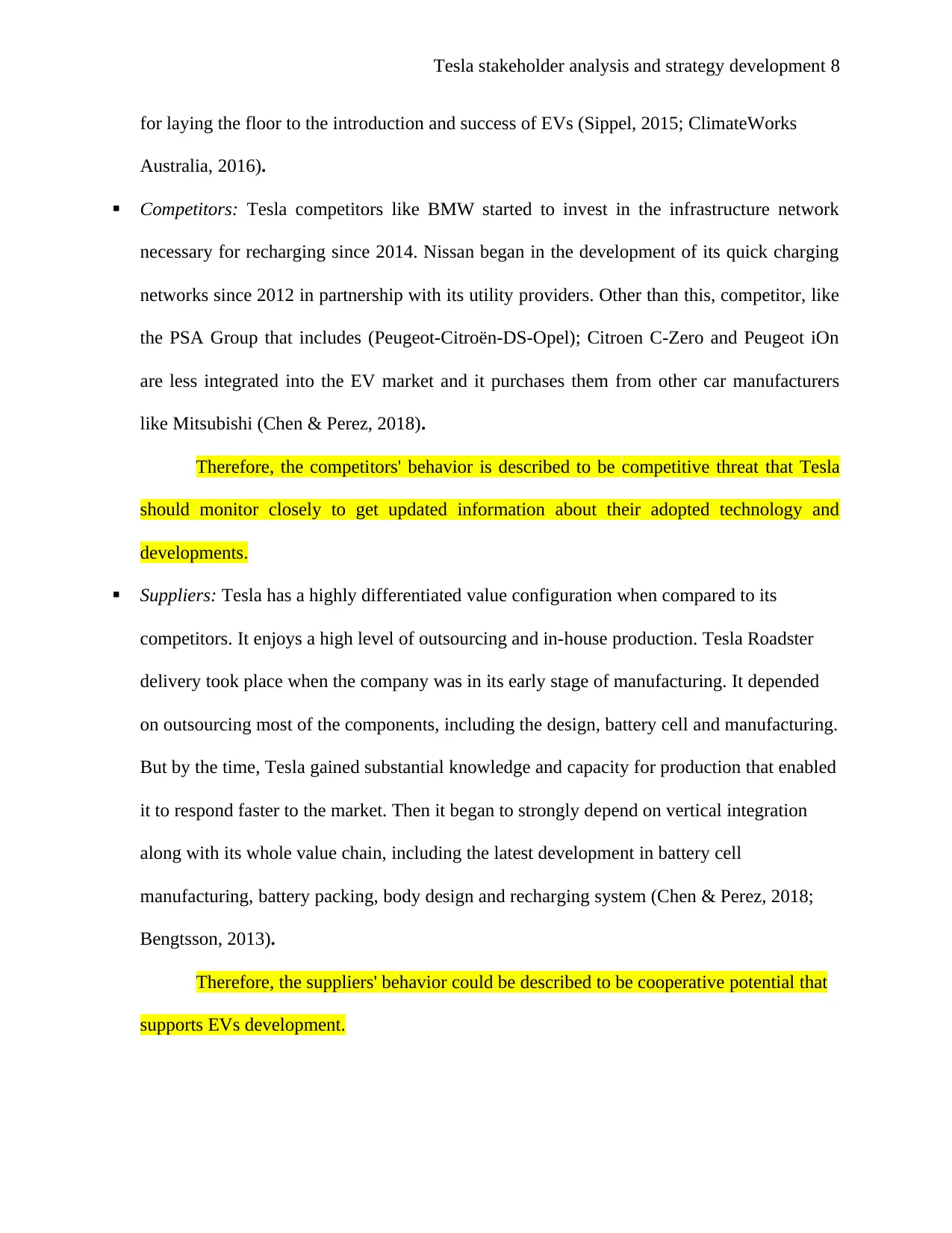
8Tesla stakeholder analysis and strategy development
for laying the floor to the introduction and success of EVs (Sippel, 2015; ClimateWorks
Australia, 2016).
Competitors: Tesla competitors like BMW started to invest in the infrastructure network
necessary for recharging since 2014. Nissan began in the development of its quick charging
networks since 2012 in partnership with its utility providers. Other than this, competitor, like
the PSA Group that includes (Peugeot-Citroën-DS-Opel); Citroen C-Zero and Peugeot iOn
are less integrated into the EV market and it purchases them from other car manufacturers
like Mitsubishi (Chen & Perez, 2018).
Therefore, the competitors' behavior is described to be competitive threat that Tesla
should monitor closely to get updated information about their adopted technology and
developments.
Suppliers: Tesla has a highly differentiated value configuration when compared to its
competitors. It enjoys a high level of outsourcing and in-house production. Tesla Roadster
delivery took place when the company was in its early stage of manufacturing. It depended
on outsourcing most of the components, including the design, battery cell and manufacturing.
But by the time, Tesla gained substantial knowledge and capacity for production that enabled
it to respond faster to the market. Then it began to strongly depend on vertical integration
along with its whole value chain, including the latest development in battery cell
manufacturing, battery packing, body design and recharging system (Chen & Perez, 2018;
Bengtsson, 2013).
Therefore, the suppliers' behavior could be described to be cooperative potential that
supports EVs development.
for laying the floor to the introduction and success of EVs (Sippel, 2015; ClimateWorks
Australia, 2016).
Competitors: Tesla competitors like BMW started to invest in the infrastructure network
necessary for recharging since 2014. Nissan began in the development of its quick charging
networks since 2012 in partnership with its utility providers. Other than this, competitor, like
the PSA Group that includes (Peugeot-Citroën-DS-Opel); Citroen C-Zero and Peugeot iOn
are less integrated into the EV market and it purchases them from other car manufacturers
like Mitsubishi (Chen & Perez, 2018).
Therefore, the competitors' behavior is described to be competitive threat that Tesla
should monitor closely to get updated information about their adopted technology and
developments.
Suppliers: Tesla has a highly differentiated value configuration when compared to its
competitors. It enjoys a high level of outsourcing and in-house production. Tesla Roadster
delivery took place when the company was in its early stage of manufacturing. It depended
on outsourcing most of the components, including the design, battery cell and manufacturing.
But by the time, Tesla gained substantial knowledge and capacity for production that enabled
it to respond faster to the market. Then it began to strongly depend on vertical integration
along with its whole value chain, including the latest development in battery cell
manufacturing, battery packing, body design and recharging system (Chen & Perez, 2018;
Bengtsson, 2013).
Therefore, the suppliers' behavior could be described to be cooperative potential that
supports EVs development.
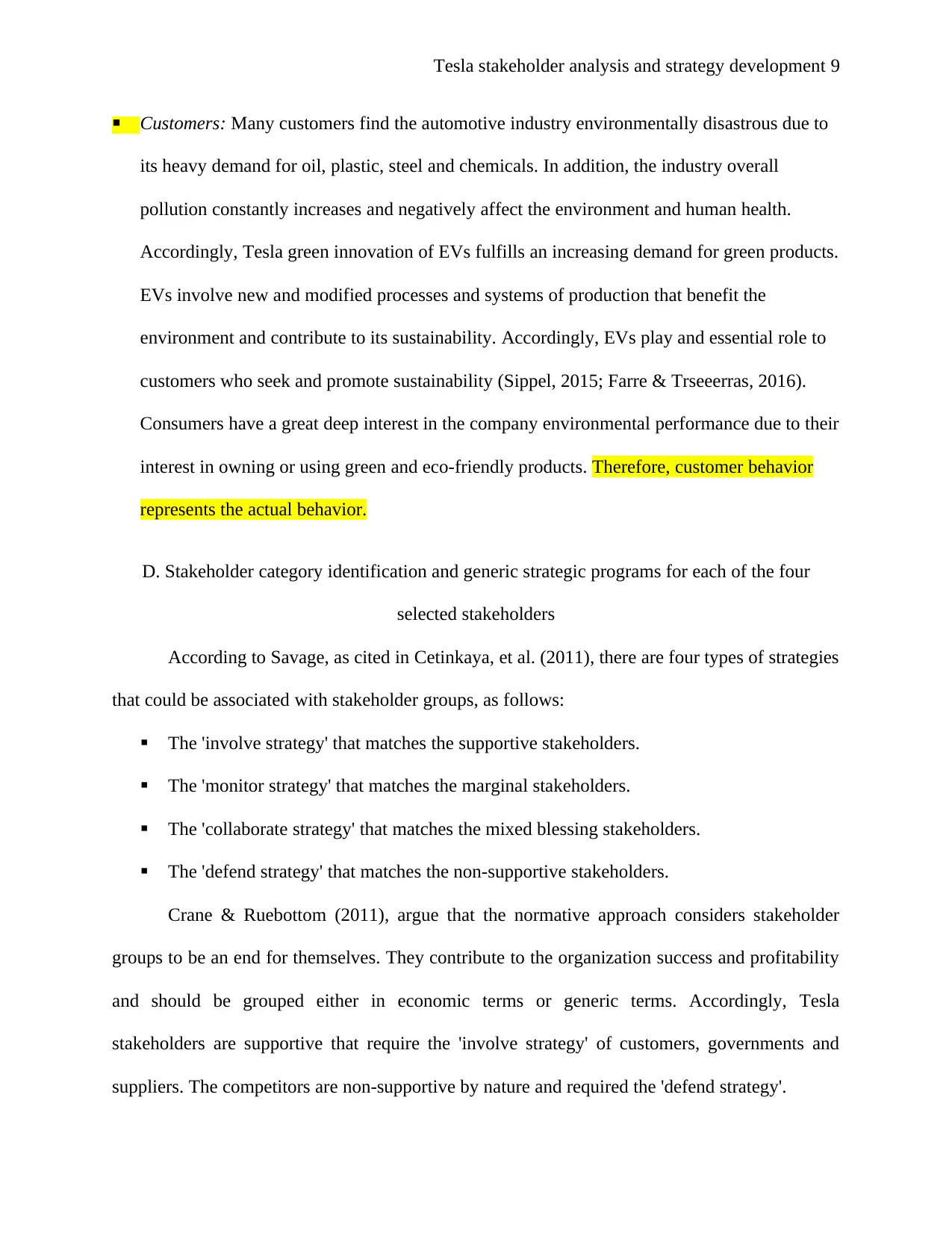
9Tesla stakeholder analysis and strategy development
Customers: Many customers find the automotive industry environmentally disastrous due to
its heavy demand for oil, plastic, steel and chemicals. In addition, the industry overall
pollution constantly increases and negatively affect the environment and human health.
Accordingly, Tesla green innovation of EVs fulfills an increasing demand for green products.
EVs involve new and modified processes and systems of production that benefit the
environment and contribute to its sustainability. Accordingly, EVs play and essential role to
customers who seek and promote sustainability (Sippel, 2015; Farre & Trseeerras, 2016).
Consumers have a great deep interest in the company environmental performance due to their
interest in owning or using green and eco-friendly products. Therefore, customer behavior
represents the actual behavior.
D. Stakeholder category identification and generic strategic programs for each of the four
selected stakeholders
According to Savage, as cited in Cetinkaya, et al. (2011), there are four types of strategies
that could be associated with stakeholder groups, as follows:
The 'involve strategy' that matches the supportive stakeholders.
The 'monitor strategy' that matches the marginal stakeholders.
The 'collaborate strategy' that matches the mixed blessing stakeholders.
The 'defend strategy' that matches the non-supportive stakeholders.
Crane & Ruebottom (2011), argue that the normative approach considers stakeholder
groups to be an end for themselves. They contribute to the organization success and profitability
and should be grouped either in economic terms or generic terms. Accordingly, Tesla
stakeholders are supportive that require the 'involve strategy' of customers, governments and
suppliers. The competitors are non-supportive by nature and required the 'defend strategy'.
Customers: Many customers find the automotive industry environmentally disastrous due to
its heavy demand for oil, plastic, steel and chemicals. In addition, the industry overall
pollution constantly increases and negatively affect the environment and human health.
Accordingly, Tesla green innovation of EVs fulfills an increasing demand for green products.
EVs involve new and modified processes and systems of production that benefit the
environment and contribute to its sustainability. Accordingly, EVs play and essential role to
customers who seek and promote sustainability (Sippel, 2015; Farre & Trseeerras, 2016).
Consumers have a great deep interest in the company environmental performance due to their
interest in owning or using green and eco-friendly products. Therefore, customer behavior
represents the actual behavior.
D. Stakeholder category identification and generic strategic programs for each of the four
selected stakeholders
According to Savage, as cited in Cetinkaya, et al. (2011), there are four types of strategies
that could be associated with stakeholder groups, as follows:
The 'involve strategy' that matches the supportive stakeholders.
The 'monitor strategy' that matches the marginal stakeholders.
The 'collaborate strategy' that matches the mixed blessing stakeholders.
The 'defend strategy' that matches the non-supportive stakeholders.
Crane & Ruebottom (2011), argue that the normative approach considers stakeholder
groups to be an end for themselves. They contribute to the organization success and profitability
and should be grouped either in economic terms or generic terms. Accordingly, Tesla
stakeholders are supportive that require the 'involve strategy' of customers, governments and
suppliers. The competitors are non-supportive by nature and required the 'defend strategy'.
⊘ This is a preview!⊘
Do you want full access?
Subscribe today to unlock all pages.

Trusted by 1+ million students worldwide
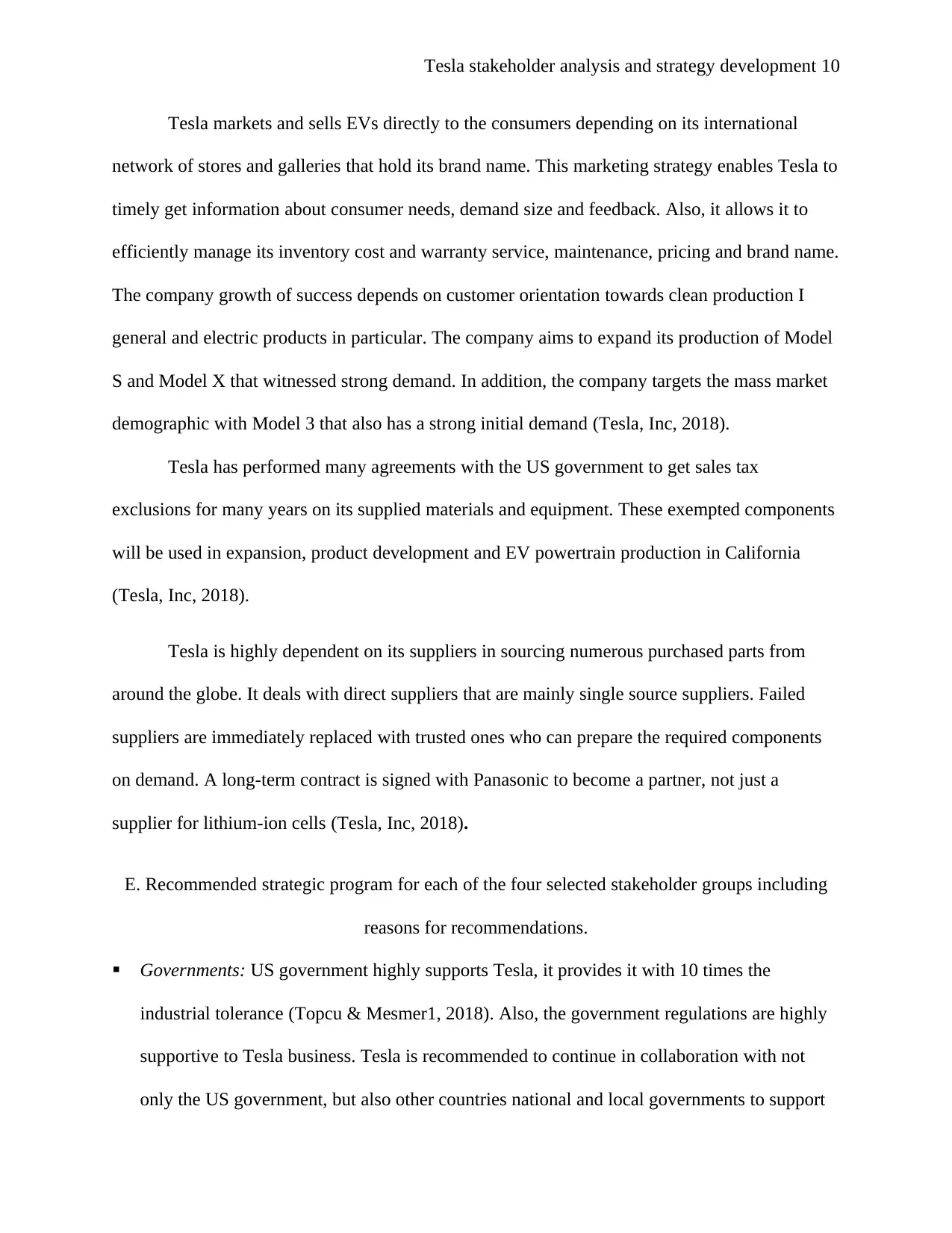
10Tesla stakeholder analysis and strategy development
Tesla markets and sells EVs directly to the consumers depending on its international
network of stores and galleries that hold its brand name. This marketing strategy enables Tesla to
timely get information about consumer needs, demand size and feedback. Also, it allows it to
efficiently manage its inventory cost and warranty service, maintenance, pricing and brand name.
The company growth of success depends on customer orientation towards clean production I
general and electric products in particular. The company aims to expand its production of Model
S and Model X that witnessed strong demand. In addition, the company targets the mass market
demographic with Model 3 that also has a strong initial demand (Tesla, Inc, 2018).
Tesla has performed many agreements with the US government to get sales tax
exclusions for many years on its supplied materials and equipment. These exempted components
will be used in expansion, product development and EV powertrain production in California
(Tesla, Inc, 2018).
Tesla is highly dependent on its suppliers in sourcing numerous purchased parts from
around the globe. It deals with direct suppliers that are mainly single source suppliers. Failed
suppliers are immediately replaced with trusted ones who can prepare the required components
on demand. A long-term contract is signed with Panasonic to become a partner, not just a
supplier for lithium-ion cells (Tesla, Inc, 2018).
E. Recommended strategic program for each of the four selected stakeholder groups including
reasons for recommendations.
Governments: US government highly supports Tesla, it provides it with 10 times the
industrial tolerance (Topcu & Mesmer1, 2018). Also, the government regulations are highly
supportive to Tesla business. Tesla is recommended to continue in collaboration with not
only the US government, but also other countries national and local governments to support
Tesla markets and sells EVs directly to the consumers depending on its international
network of stores and galleries that hold its brand name. This marketing strategy enables Tesla to
timely get information about consumer needs, demand size and feedback. Also, it allows it to
efficiently manage its inventory cost and warranty service, maintenance, pricing and brand name.
The company growth of success depends on customer orientation towards clean production I
general and electric products in particular. The company aims to expand its production of Model
S and Model X that witnessed strong demand. In addition, the company targets the mass market
demographic with Model 3 that also has a strong initial demand (Tesla, Inc, 2018).
Tesla has performed many agreements with the US government to get sales tax
exclusions for many years on its supplied materials and equipment. These exempted components
will be used in expansion, product development and EV powertrain production in California
(Tesla, Inc, 2018).
Tesla is highly dependent on its suppliers in sourcing numerous purchased parts from
around the globe. It deals with direct suppliers that are mainly single source suppliers. Failed
suppliers are immediately replaced with trusted ones who can prepare the required components
on demand. A long-term contract is signed with Panasonic to become a partner, not just a
supplier for lithium-ion cells (Tesla, Inc, 2018).
E. Recommended strategic program for each of the four selected stakeholder groups including
reasons for recommendations.
Governments: US government highly supports Tesla, it provides it with 10 times the
industrial tolerance (Topcu & Mesmer1, 2018). Also, the government regulations are highly
supportive to Tesla business. Tesla is recommended to continue in collaboration with not
only the US government, but also other countries national and local governments to support
Paraphrase This Document
Need a fresh take? Get an instant paraphrase of this document with our AI Paraphraser
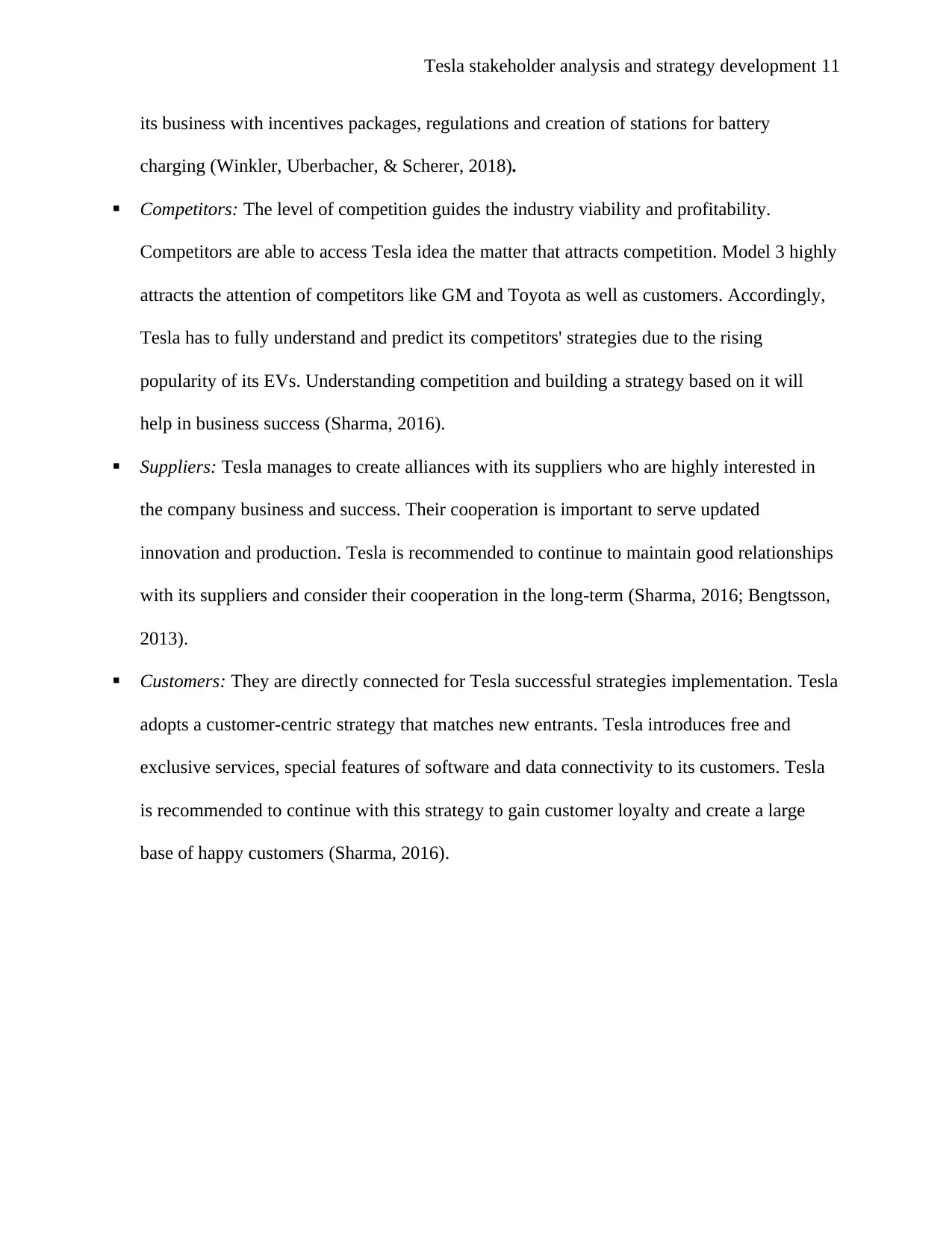
11Tesla stakeholder analysis and strategy development
its business with incentives packages, regulations and creation of stations for battery
charging (Winkler, Uberbacher, & Scherer, 2018).
Competitors: The level of competition guides the industry viability and profitability.
Competitors are able to access Tesla idea the matter that attracts competition. Model 3 highly
attracts the attention of competitors like GM and Toyota as well as customers. Accordingly,
Tesla has to fully understand and predict its competitors' strategies due to the rising
popularity of its EVs. Understanding competition and building a strategy based on it will
help in business success (Sharma, 2016).
Suppliers: Tesla manages to create alliances with its suppliers who are highly interested in
the company business and success. Their cooperation is important to serve updated
innovation and production. Tesla is recommended to continue to maintain good relationships
with its suppliers and consider their cooperation in the long-term (Sharma, 2016; Bengtsson,
2013).
Customers: They are directly connected for Tesla successful strategies implementation. Tesla
adopts a customer-centric strategy that matches new entrants. Tesla introduces free and
exclusive services, special features of software and data connectivity to its customers. Tesla
is recommended to continue with this strategy to gain customer loyalty and create a large
base of happy customers (Sharma, 2016).
its business with incentives packages, regulations and creation of stations for battery
charging (Winkler, Uberbacher, & Scherer, 2018).
Competitors: The level of competition guides the industry viability and profitability.
Competitors are able to access Tesla idea the matter that attracts competition. Model 3 highly
attracts the attention of competitors like GM and Toyota as well as customers. Accordingly,
Tesla has to fully understand and predict its competitors' strategies due to the rising
popularity of its EVs. Understanding competition and building a strategy based on it will
help in business success (Sharma, 2016).
Suppliers: Tesla manages to create alliances with its suppliers who are highly interested in
the company business and success. Their cooperation is important to serve updated
innovation and production. Tesla is recommended to continue to maintain good relationships
with its suppliers and consider their cooperation in the long-term (Sharma, 2016; Bengtsson,
2013).
Customers: They are directly connected for Tesla successful strategies implementation. Tesla
adopts a customer-centric strategy that matches new entrants. Tesla introduces free and
exclusive services, special features of software and data connectivity to its customers. Tesla
is recommended to continue with this strategy to gain customer loyalty and create a large
base of happy customers (Sharma, 2016).
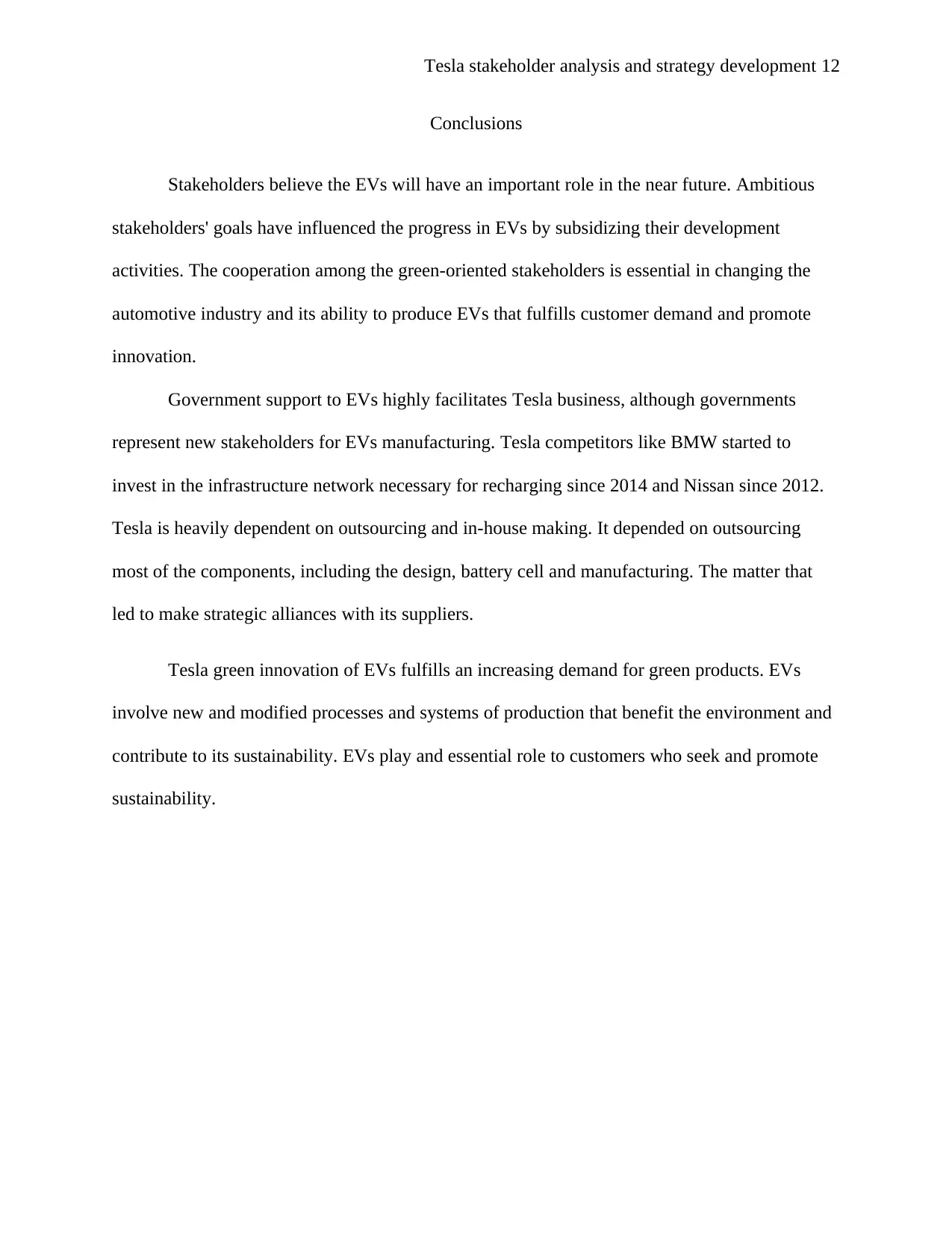
12Tesla stakeholder analysis and strategy development
Conclusions
Stakeholders believe the EVs will have an important role in the near future. Ambitious
stakeholders' goals have influenced the progress in EVs by subsidizing their development
activities. The cooperation among the green-oriented stakeholders is essential in changing the
automotive industry and its ability to produce EVs that fulfills customer demand and promote
innovation.
Government support to EVs highly facilitates Tesla business, although governments
represent new stakeholders for EVs manufacturing. Tesla competitors like BMW started to
invest in the infrastructure network necessary for recharging since 2014 and Nissan since 2012.
Tesla is heavily dependent on outsourcing and in-house making. It depended on outsourcing
most of the components, including the design, battery cell and manufacturing. The matter that
led to make strategic alliances with its suppliers.
Tesla green innovation of EVs fulfills an increasing demand for green products. EVs
involve new and modified processes and systems of production that benefit the environment and
contribute to its sustainability. EVs play and essential role to customers who seek and promote
sustainability.
Conclusions
Stakeholders believe the EVs will have an important role in the near future. Ambitious
stakeholders' goals have influenced the progress in EVs by subsidizing their development
activities. The cooperation among the green-oriented stakeholders is essential in changing the
automotive industry and its ability to produce EVs that fulfills customer demand and promote
innovation.
Government support to EVs highly facilitates Tesla business, although governments
represent new stakeholders for EVs manufacturing. Tesla competitors like BMW started to
invest in the infrastructure network necessary for recharging since 2014 and Nissan since 2012.
Tesla is heavily dependent on outsourcing and in-house making. It depended on outsourcing
most of the components, including the design, battery cell and manufacturing. The matter that
led to make strategic alliances with its suppliers.
Tesla green innovation of EVs fulfills an increasing demand for green products. EVs
involve new and modified processes and systems of production that benefit the environment and
contribute to its sustainability. EVs play and essential role to customers who seek and promote
sustainability.
⊘ This is a preview!⊘
Do you want full access?
Subscribe today to unlock all pages.

Trusted by 1+ million students worldwide
1 out of 15
Related Documents
Your All-in-One AI-Powered Toolkit for Academic Success.
+13062052269
info@desklib.com
Available 24*7 on WhatsApp / Email
![[object Object]](/_next/static/media/star-bottom.7253800d.svg)
Unlock your academic potential
Copyright © 2020–2025 A2Z Services. All Rights Reserved. Developed and managed by ZUCOL.




